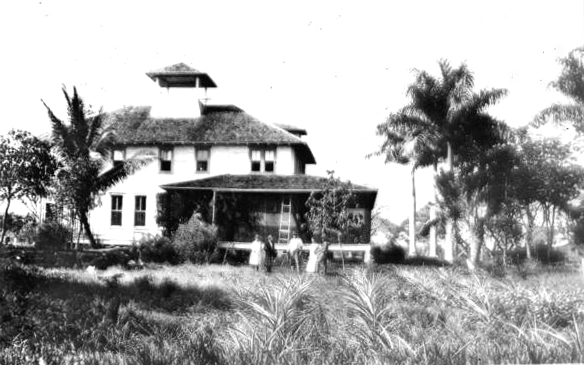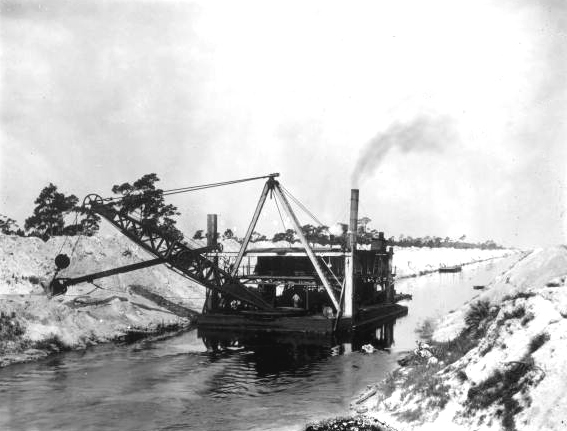Description of previous item
Description of next item
Land by the Gallon
Published May 5, 2015 by Florida Memory
An Iowa man once came to Florida after buying a plot of land and, after having seen what he had purchased, said “I have bought land by the acre, and I have bought land by the foot; but, by God, I have never before bought land by the gallon.”
He was one of many who bought land in South Florida at the turn of the 20th century during one of Florida’s biggest land booms. Spurred on by the expansion of the railroad and ambitious plans to drain the Everglades for development, land speculators bought up thousands of acres of swampland and prepared to sell it to investors and settlers from the Midwest and Northeast. Some historians refer to this feverish period of land speculation as the “swamp boom,” and the folks involved as “swamp boomers.”

Map of the Everglades Drainage District, taken from the back cover of a souvenir pamphlet made for the official opening of the Gulf to Atlantic Waterway (1912). A copy of this pamphlet is available in the Florida Collection, State Library of Florida.
The land turned out to be a popular sell almost from the start. Newspapers and pamphlets raved about the infite possibilities for farming on land in the Everglades once it had been adequately drained. One enthusiastic writer declared that all one need do was “simply tickle the soil and the bounteous crops respond to feed hungry humanity.” Prospective buyers came in droves to towns on the edge of the Glades like Miami and Fort Lauderdale, where the land salesmen were ready to do business.
Speculators often used gimmicks to heighten interest in their lands and create a sense of urgency for the would-be buyers. Richard J. Bolles, for example, held an Everglades land lottery in 1911, in which the participants would pay $240 over a period of two years for a chance to win anywhere from 10 to 640 acres of reclaimed Everglades property, plus a town lot in a planned community on the coast to be called Progresso. Bolles built a hotel on Lake Okeechobee’s south shore to lodge and impress prospective clients. It was the first two-story building ever built in the Everglades.

The Hotel Bolles, the first two-story building in the Everglades. It was built by Richard Bolles to house prospective buyers of Everglades land during the “swamp boom.” The hotel was located at Ritta (circa 1920).
There was just one problem. All of this enthusiasm – from buyers and sellers alike – stemmed from the understanding that the land would be drained in order to make farming feasible. Governor Napoleon Bonaparte Broward had campaigned in 1904 with the promise that he would achieve this goal. As governor, he oversaw the creation of a Board of Drainage Commissioners, empowered to build canals and dikes to reclaim this swampy bottom portion of the state. Canals were dug and dikes were erected, but many connected with the project quickly realized they had bitten off a bit more than they could chew. Private companies joined in the effort, but much of the land sold by promoters like Bolles remained underwater and useless for farming, at least for the moment.
Irate landowners felt duped when they saw their purchases still submerged, and they took their complaints to the courts. A number of land companies and speculators like Richard Bolles were sued by their customers for fraud, and several individuals were even convicted on criminal charges.
Meanwhile, the jokes concerning this dire situation almost wrote themselves. Some would-be settlers remarked that they’d have to attach their plows to their boats to make any headway, while others humorously wondered whether it might be more practical to raise fish instead of crops. One woman walked witlessly into a most appropriate pun when she gave testimony during a case against the land speculators. When asked how she felt upon seeing her so-called “farmland” covered in water, she said she felt “entirely at sea.”
State authorities and private land companies alike complained that their intentions were good and that Florida would be throwing away a tremendous opportunity if the drainage program were not fully supported. The boom, however, was over. Land sales and drainage projects in the Everglades did not halt completely, but they were greatly reduced for over a decade as a result of the national uproar over the business tactics of the swampland salesmen. Thousands of landowners ended up forfeiting their underwater parcels of Florida real estate for taxes. Over time, private developers and government support combined to drain more Everglades territory for farming, but the name “Everglades” would long be associated with the memory of these shady real estate dealings.

Cartoon from a pamphlet published by supporters of the Everglades drainage project. This particular group of supporters called themselves the “Back to Broward” League, a nod to Governor Napoleon Bonaparte Broward’s leadership in the drainage movement. A copy of this 1916 pamphlet is available in the Florida Collection at the State Library.
Looking for more information about the Everglades during the Florida Land Boom? We recommend Michael Grunwald’s The Swamp: The Everglades, Florida, and Politics of Paradise, available at the State Library of Florida or through your local public library.
Cite This Article
Chicago Manual of Style
(17th Edition)Florida Memory. "Land by the Gallon." Floridiana, 2015. https://www.floridamemory.com/items/show/295250.
MLA
(9th Edition)Florida Memory. "Land by the Gallon." Floridiana, 2015, https://www.floridamemory.com/items/show/295250. Accessed December 27, 2025.
APA
(7th Edition)Florida Memory. (2015, May 5). Land by the Gallon. Floridiana. Retrieved from https://www.floridamemory.com/items/show/295250

 Listen: The Bluegrass & Old-Time Program
Listen: The Bluegrass & Old-Time Program